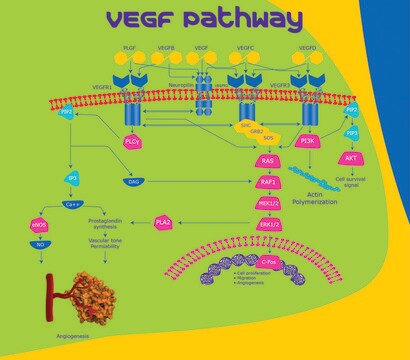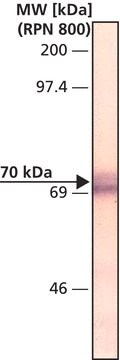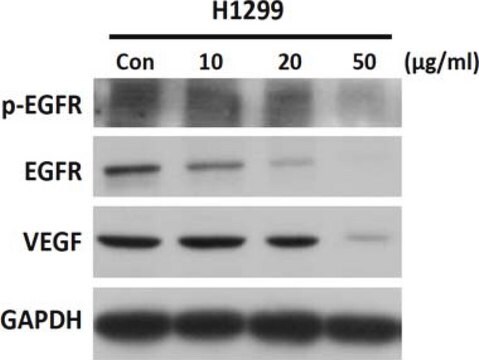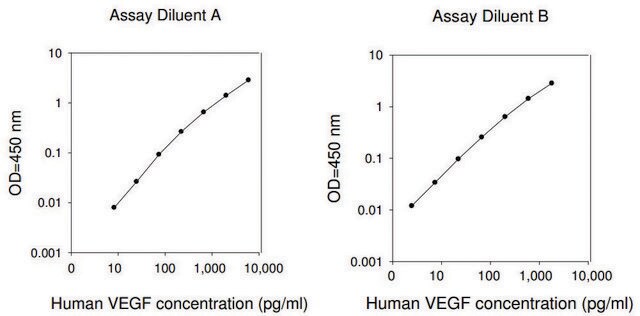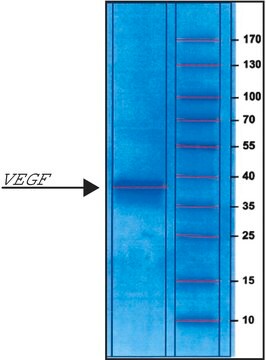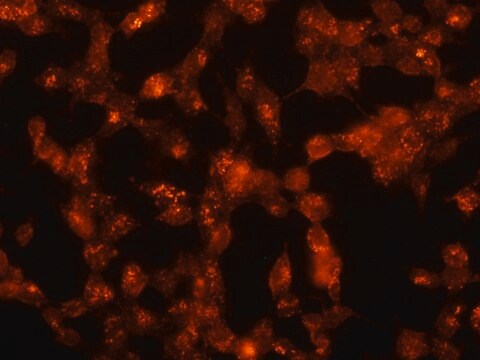V1385
VEGF Receptor-1 (Flt-1)/Fc Chimera human
>90% (SDS-PAGE), recombinant, expressed in baculovirus infected Sf21 cells, lyophilized powder
Sinonimo/i:
Vascular Endothelial Growth Factor Receptor‑1
Autenticatiper visualizzare i prezzi riservati alla tua organizzazione & contrattuali
About This Item
Prodotti consigliati
Origine biologica
human
Livello qualitativo
Ricombinante
expressed in baculovirus infected Sf21 cells
Saggio
>90% (SDS-PAGE)
Stato
lyophilized powder
Potenza
≤35 ng/mL ED50
PM
predicted mol wt ~100 kDa
Confezionamento
pkg of 50 μg
Condizioni di stoccaggio
avoid repeated freeze/thaw cycles
Impurezze
endotoxin, tested
N° accesso UniProt
Temperatura di conservazione
−20°C
Informazioni sul gene
human ... FLT1(2321)
Applicazioni
VEGF Receptor-1 (Flt-1)/Fc chimera human may be used tostudy vasculogenesis and angiogenesis.
Azioni biochim/fisiol
VEGF Receptor-1 (VEGF R1) also known as Flt-1 belongs to class III subfamily of RTKs and is a potent VEGF antagonist expressed mainly in endothelial cells. VEGF R1 binds to vascular endothelial growth factor B (VEGF-B) and regulates the activity of plasminogen activator in endothelial cells. It also assists endothelial cells in the proper spatial organization of lumen-containing vessels. Additionally, alternatively spliced VEGF R1 pre-mRNA helps in regulating the VEGF activity in angiogenesis. VEGF R1 also activates PLC gamma which in turn produces cellular signaling molecules diacylglycerol as well as inositol 1,4,5-trisphosphate and activates protein kinase C.
VEGF receptors, class III receptor tyrosine kinases, have seven Ig like extracellular motifs and a tyrosine kinase intracellular domain split by a kinase insert sequence. VEGFR 1 was originally called fms like tyrosine kinase 1 (flt 1), indicating its homology to receptors of PDGF, M CSF, and SCF. VEGFR 1 is one of the five receptor tyrosine kinases (KDR/Flk-1, Flt-4, tie-1 and tek/tie-2) whose expression is almost exclusively restricted to endothelial cells. These receptors are likely to play central roles in vasculogenesis and angiogenesis. Recombinant VEGF R1 binds VEGF with high affinity and is a potent VEGF inhibitor. VEGFR 1 and 2 are both expressed in an endothelial cell-specific manner and are detectable in virtually all tissues in adults and embryos. Hypoxia induces endothelial cell expression of VEGFR 1 but not VEGFR 2. Monocytes express VEGFR 1 and 2 and can migrate to the site of VEGF release, but this response appears to be VEGFR 1 mediated. VEGFR 2 is also expressed in pancreatic duct cells. VEGFR 2 is involved in commitment of endothelial-cell lineages and to cell proliferation, while VEGFR 1 seems to be responsible for guiding endothelial cells into the proper spatial organization into lumen-containing vessels. VEGFR 2 is a key marker for pluripotent HSCs. Neurophilins, a group of unrelated receptors for some VEGF family members may also act as coreceptors to facilitate VEGF binding to VEGFR 2. VEGFR 3 is a specific marker for lymphatic vessels. VEGFR 3 has also been detected on some high endothelial venules, in embryonic pre-lymphatic blood vessels, some tumor blood vessels, and certain hematopoietic and leukemia cells.
Stato fisico
Lyophilized from a 0.2 μm filtered solution in 20 mM MOPS, 500 mM sodium chloride, 0.05% CHAPS, pH 7.0 containing 50 μg bovine serum albumin per 1 μg of cytokine
Risultati analitici
The biological activity is measured by its ability to Inhibit the VEGF-dependent proliferation of human umbilical vein endothelial cells.
Codice della classe di stoccaggio
13 - Non Combustible Solids
Classe di pericolosità dell'acqua (WGK)
WGK 3
Punto d’infiammabilità (°F)
Not applicable
Punto d’infiammabilità (°C)
Not applicable
Dispositivi di protezione individuale
Eyeshields, Gloves, type N95 (US)
Scegli una delle versioni più recenti:
Possiedi già questo prodotto?
I documenti relativi ai prodotti acquistati recentemente sono disponibili nell’Archivio dei documenti.
A Sawano et al.
Biochemical and biophysical research communications, 238(2), 487-491 (1997-09-23)
Flt-1, a tyrosine kinase receptor for vascular endothelial growth factor (VEGF), plays important roles in the angiogenesis required for embryogenesis and in monocyte/macrophage migration. However, the signal transduction of Flt-1 is poorly understood due to its very weak tyrosine kinase
Y He et al.
Molecular endocrinology (Baltimore, Md.), 13(4), 537-545 (1999-04-09)
Angiogenesis is essential for normal mammalian development and is controlled by the local balance of pro- and antiangiogenic factors. Here we describe a novel mouse cDNA sequence encoding sFLT-1 that is a potent antagonist to vascular endothelial growth factor (VEGF)
B Olofsson et al.
Proceedings of the National Academy of Sciences of the United States of America, 95(20), 11709-11714 (1998-09-30)
The vascular endothelial growth factor (VEGF) family has recently expanded by the identification and cloning of three additional members, namely VEGF-B, VEGF-C, and VEGF-D. In this study we demonstrate that VEGF-B binds selectively to VEGF receptor-1/Flt-1. This binding can be
Il team dei nostri ricercatori vanta grande esperienza in tutte le aree della ricerca quali Life Science, scienza dei materiali, sintesi chimica, cromatografia, discipline analitiche, ecc..
Contatta l'Assistenza Tecnica.